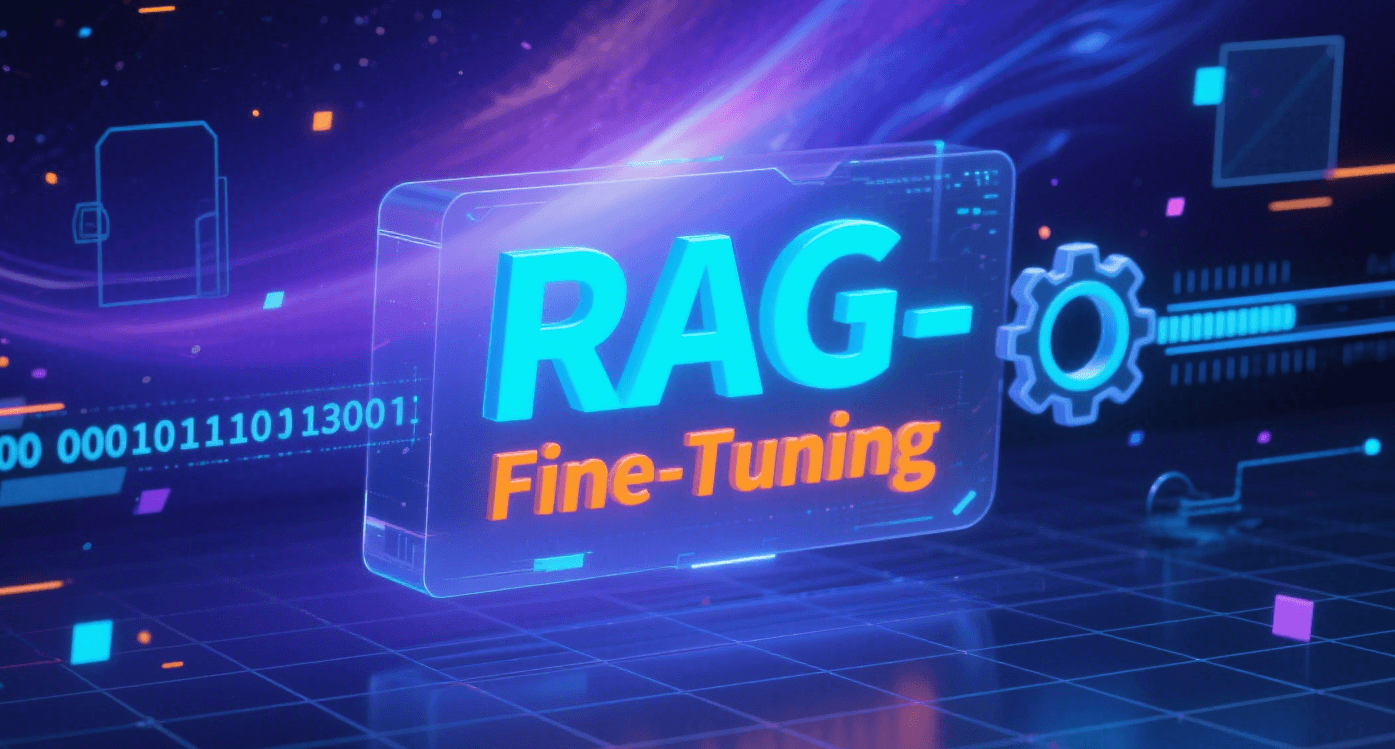Artificial intelligence large models iterate rapidly. For enterprises implementing AI technologies, a core issue is how to make pre-trained models better adapt to actual business needs. RAG vs Fine-Tuning is a key consideration here. Retrieval Augmented Generation (RAG) and Fine-Tuning are two mainstream technical solutions. They differ significantly in principles, applicable scenarios, and implementation costs. Choosing the right solution often requires a comprehensive judgment based on business goals, data characteristics, and resource allocation.
What is Retrieval Augmented Generation (RAG)
Retrieval Augmented Generation (RAG) is a hybrid technology that combines “retrieval” and “generation”. Its core logic is to enable large models to retrieve relevant information from an external knowledge base before generating responses, and then reason and generate based on the retrieved content.
Specifically, the workflow of RAG can be divided into three steps: First, process enterprise private domain data (such as documents, databases, web pages, etc.) into structured vector data and store it in a vector database. Second, when a user inputs a query, the system will quickly retrieve information fragments highly relevant to the query from the vector database. Finally, the large model uses these retrieved information as “reference materials” and combines its own pre-trained knowledge to generate accurate and evidence-based responses.
The greatest advantage of this technology is that it allows the model to “master” the latest or domain-specific knowledge without modifying model parameters. For example, in the financial industry, when policy documents and market dynamics are frequently updated, RAG can retrieve new documents in real-time to ensure that the information output by the model is consistent with the latest policies, avoiding reliance on outdated pre-trained data.
What is Fine-Tuning
Fine-Tuning refers to a technical method that further trains a pre-trained large model using datasets specific to a certain domain or task, and adjusts some or all parameters of the model to make it more suitable for the target task.
A pre-trained model is like a “general knowledge base”, covering extensive common sense and basic logic. However, when facing vertical fields (such as medical care, law) or specific tasks (such as sentiment analysis, code generation), it may have insufficient accuracy. Fine-Tuning enables the model to learn domain knowledge and task rules from specific data through “secondary training”. For example, a model fine-tuned with a large amount of medical record data can more accurately identify medical terms and interpret diagnostic reports.
The effect of fine-tuning is closely related to the quality and quantity of training data: high-quality annotated data can guide the model to learn key rules faster, while a sufficient amount of data can reduce the risk of model overfitting and improve generalization ability. However, this process requires continuous computing resource support to complete multiple rounds of parameter iterative optimization.
Key Differences: RAG vs Fine Tuning
Although both RAG and Fine-Tuning aim to “improve model practicality”, they have essential differences in technical logic and implementation performance, mainly reflected in the following three dimensions:
Performance Metrics
- The performance of RAG is highly dependent on the accuracy of the retrieval system. If the vector database has comprehensive information coverage and efficient retrieval algorithms, the model can quickly obtain accurate references, and the output results have strong factual consistency and timeliness; however, if irrelevant information is retrieved or key content is missing, the generated results may be biased.
- The performance of Fine-Tuning is reflected in the model’s “in-depth understanding” of specific tasks. A fully fine-tuned model can internalize domain knowledge into parameters, showing stronger task adaptability and output fluency when dealing with complex logical reasoning (such as legal clause interpretation, industrial fault diagnosis), and its response speed is more stable without relying on external retrieval.
Implementation Complexity
- The complexity of RAG is concentrated on “knowledge base construction and maintenance”. Enterprises need to build a vector database, design data cleaning and embedding processes, and continuously update the content of the knowledge base (such as adding new documents, deleting outdated information). The technical threshold is mainly reflected in the optimization of the retrieval system, with little modification to the model itself.
- The complexity of Fine-Tuning is reflected in the “full-process chain”. From annotating high-quality training data, designing training strategies (such as learning rate, number of iterations), to monitoring model convergence and avoiding overfitting, each step requires the participation of a professional algorithm team. In addition, multiple rounds of testing are required after fine-tuning to ensure the stability of the model in the target task, making the overall process more cumbersome.
Cost Considerations
- The cost of RAG mainly comes from the storage cost of the vector database, the computing power consumption of the retrieval service, and the continuous maintenance cost of the knowledge base. Since there is no need to modify model parameters, its initial investment is low, but with the growth of data volume, the marginal cost of storage and retrieval may gradually increase.
- The cost of Fine-Tuning is concentrated on computing resources. In the process of model training, high-performance GPUs (such as NVIDIA H100, H200) are needed for large-scale parallel computing. Especially for large models with more than 10 billion parameters, a single fine-tuning may cost thousands or even tens of thousands of yuan in computing power. In addition, the acquisition of high-quality annotated data (such as manual annotation) will also increase the cost.
In terms of cost optimization, WhaleFlux, an intelligent GPU resource management tool designed for AI enterprises, can provide efficient support for the implementation of both technologies. Its high-performance GPUs such as NVIDIA H100, NVIDIA H200, NVIDIA A100, and NVIDIA RTX 4090 can be purchased or rented (with a minimum rental period of one month, and no hourly rental service is provided) to meet the stable computing power needs of RAG retrieval services and the large-scale training needs of Fine-Tuning, helping enterprises control costs while improving the deployment speed and stability of large models.
When to Use RAG?
Dynamic and Expanding Datasets
When enterprises need to process high-frequency updated data, RAG is a better choice. For example, the product information (price, inventory, specifications) of e-commerce platforms changes every day, and news applications need to incorporate hot events in real-time. In these scenarios, if fine-tuning is adopted, each data update requires retraining the model, which is not only time-consuming but also leads to a surge in costs. With RAG, as long as new data is synchronized to the vector database, the model can “immediately master” new information, significantly improving efficiency.
High Accuracy Requirements
In fields with high requirements for traceability and accuracy of output results (such as law, medical care), RAG has more obvious advantages. For example, lawyers need to generate legal opinions based on the latest legal provisions, and doctors need to refer to patients’ latest inspection reports to give diagnostic suggestions. RAG can directly retrieve specific legal clauses or inspection data and use them as the “basis” for generating content, ensuring the accuracy of the results and facilitating subsequent verification.
In such scenarios, efficient retrieval and generation rely on stable computing power support. By optimizing the utilization efficiency of multi-GPU clusters, WhaleFlux can provide sufficient computing power for vector retrieval and model reasoning of RAG systems, ensuring efficient response even when the data volume surges and reducing the cloud computing costs of enterprises.
When to Use Fine Tuning?
Fine-Tuning is more suitable for the following business scenarios:
Specific Tasks and Domains
When enterprises need models to focus on single and fixed tasks, fine-tuning can bring more in-depth optimization. For example, the “credit risk assessment model” of financial institutions needs to accurately identify risk indicators in financial statements, and the “equipment fault diagnosis model” in intelligent manufacturing scenarios needs to understand the operating parameter rules of specific equipment. These tasks have high requirements for the “internalization” of domain knowledge, and fine-tuning can enable the model to integrate task logic into parameters, showing more stable performance when dealing with complex cases.
Resource Constraints
The “resource constraints” here do not refer to resource scarcity, but to the need for long-term and stable computing resource investment to support continuous optimization. Fine-tuning is not a one-time task. Enterprises need to continuously iterate training data and optimize model parameters according to business feedback. At this time, it is crucial to choose high-performance and cost-controllable GPU resources. The NVIDIA H100, NVIDIA H200, and other GPUs provided by WhaleFlux support a minimum rental period of one month without hourly payment, which can meet the long-term training needs of fine-tuning. At the same time, through resource management optimization, it helps enterprises control costs in long-term investment.
Deciding Between RAG and Fine-Tuning
Choosing between RAG and Fine-Tuning requires comprehensive judgment based on business goals, data characteristics, and resource allocation. The core considerations include:
- Data dynamics: Is the data updated frequently and widely? Prioritize RAG; Is the data relatively stable and concentrated in specific fields? Consider Fine-Tuning.
- Task complexity: Is the task mainly “information matching and integration” (such as customer service Q&A)? RAG is more efficient; Does the task involve “in-depth logical reasoning” (such as professional field decision-making)? Fine-Tuning is more suitable.
- Cost and resources: For short-term trial and error or limited budget? RAG has lower initial costs; For long-term engagement in specific tasks and ability to bear continuous computing power investment? Fine-Tuning has more obvious long-term benefits.
In actual business, the two are not completely opposed. Many enterprises use a “RAG + Fine-Tuning” hybrid approach: first, fine-tuning helps the model master basic domain logic; then RAG supplements real-time information. For example, an intelligent customer service system uses fine-tuning to learn industry terms and service processes, then uses RAG to get users’ latest order information or product updates—balancing efficiency and accuracy.

